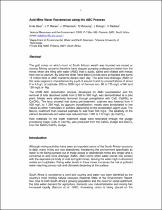JavaScript is disabled for your browser. Some features of this site may not work without it.
- ResearchSpace
- →
- Research Publications/Outputs
- →
- Conference Publications
- →
- View Item
| dc.contributor.author |
De Beer, Morris

|
|
| dc.contributor.author |
Maree, JP

|
|
| dc.contributor.author |
Wilsenach, J

|
|
| dc.contributor.author |
Motaung, S

|
|
| dc.contributor.author |
Bologo, L

|
|
| dc.contributor.author |
Radebe, V

|
|
| dc.date.accessioned | 2011-08-29T13:13:13Z | |
| dc.date.available | 2011-08-29T13:13:13Z | |
| dc.date.issued | 2010-09 | |
| dc.identifier.citation | De Beer, M., Maree, J.P., Wilsenach, J., et al. 2010. Acid mine water reclamation using the ABC process. International Mine Water Association Symposium. Cape Brenton University, Sydney, Nova Scotia, Canada, 4-9 Sept 2010, pp. 6 | en_US |
| dc.identifier.uri | http://hdl.handle.net/10204/5137 | |
| dc.description | International Mine Water Association Symposium. Cape Brenton University, Sydney, Nova Scotia, Canada, 4-9 Sept 2010 | en_US |
| dc.description.abstract | The gold mines on which much of South Africa’s wealth was founded are closed or closing. Mining concerns therefore have stopped pumping underground water from the mines which are filling with water (AMD) that is acidic, saline and vitiated with metals from iron to uranium. By 2002 the West Rand Basin’s mines were all flooded and some 15 million litres of AMD started to decant each day. The acid mine drainage (AMD) of this area (region) is characterised by a pH of around 3 and by concentrations of about 2 to 4.5 g/L of sulphate, 250 to 1200 mg/L of Ferrous iron, 60 to 175 mg/L of Mn and 120 mg/L of Mg. The CSIR ABC desalination process, developed for AMD neutralisation and the removal of total dissolved solids from 2 600 to 360 mg/L was demonstrated at a pilot plant. Metals were effectively removed through precipitation with CaS, Ca(HS)2 or Ca(OH)2. The tests showed that during pre-treatment, sulphate was lowered from 4 500 mg/L to 1 250 mg/L by gypsum crystallization; metals were precipitated to low values as either hydroxides or sulfides, depending on the precipitation agent used. The BaCO3 treatment then lowered sulphate to less than 100 mg/L. The alkalinity of the calcium bicarbonate-rich water was reduced from 1 000 to 110 mg/L (as CaCO3). Raw materials for the water treatment stage were recovered through the sludge processing stage. CaS or Ca(HS)2 was produced from the CaSO4 sludge and BaCO3 from the BaSO4/CaCO3 sludge | en_US |
| dc.language.iso | en | en_US |
| dc.relation.ispartofseries | Workflow;4531 | |
| dc.subject | ABC process | en_US |
| dc.subject | AMD treatment | en_US |
| dc.subject | BaCO3 | en_US |
| dc.subject | Sludge processing | en_US |
| dc.subject | Acid mine water | en_US |
| dc.subject | Mine water | en_US |
| dc.title | Acid mine water reclamation using the ABC process | en_US |
| dc.type | Conference Presentation | en_US |
| dc.identifier.apacitation | De Beer, M., Maree, J., Wilsenach, J., Motaung, S., Bologo, L., & Radebe, V. (2010). Acid mine water reclamation using the ABC process. http://hdl.handle.net/10204/5137 | en_ZA |
| dc.identifier.chicagocitation | De Beer, Morris, JP Maree, J Wilsenach, S Motaung, L Bologo, and V Radebe. "Acid mine water reclamation using the ABC process." (2010): http://hdl.handle.net/10204/5137 | en_ZA |
| dc.identifier.vancouvercitation | De Beer M, Maree J, Wilsenach J, Motaung S, Bologo L, Radebe V, Acid mine water reclamation using the ABC process; 2010. http://hdl.handle.net/10204/5137 . | en_ZA |
| dc.identifier.ris | TY - Conference Presentation AU - De Beer, Morris AU - Maree, JP AU - Wilsenach, J AU - Motaung, S AU - Bologo, L AU - Radebe, V AB - The gold mines on which much of South Africa’s wealth was founded are closed or closing. Mining concerns therefore have stopped pumping underground water from the mines which are filling with water (AMD) that is acidic, saline and vitiated with metals from iron to uranium. By 2002 the West Rand Basin’s mines were all flooded and some 15 million litres of AMD started to decant each day. The acid mine drainage (AMD) of this area (region) is characterised by a pH of around 3 and by concentrations of about 2 to 4.5 g/L of sulphate, 250 to 1200 mg/L of Ferrous iron, 60 to 175 mg/L of Mn and 120 mg/L of Mg. The CSIR ABC desalination process, developed for AMD neutralisation and the removal of total dissolved solids from 2 600 to 360 mg/L was demonstrated at a pilot plant. Metals were effectively removed through precipitation with CaS, Ca(HS)2 or Ca(OH)2. The tests showed that during pre-treatment, sulphate was lowered from 4 500 mg/L to 1 250 mg/L by gypsum crystallization; metals were precipitated to low values as either hydroxides or sulfides, depending on the precipitation agent used. The BaCO3 treatment then lowered sulphate to less than 100 mg/L. The alkalinity of the calcium bicarbonate-rich water was reduced from 1 000 to 110 mg/L (as CaCO3). Raw materials for the water treatment stage were recovered through the sludge processing stage. CaS or Ca(HS)2 was produced from the CaSO4 sludge and BaCO3 from the BaSO4/CaCO3 sludge DA - 2010-09 DB - ResearchSpace DP - CSIR KW - ABC process KW - AMD treatment KW - BaCO3 KW - Sludge processing KW - Acid mine water KW - Mine water LK - https://researchspace.csir.co.za PY - 2010 T1 - Acid mine water reclamation using the ABC process TI - Acid mine water reclamation using the ABC process UR - http://hdl.handle.net/10204/5137 ER - | en_ZA |






